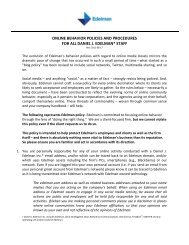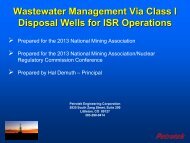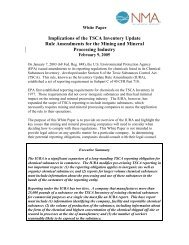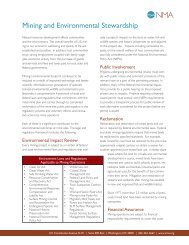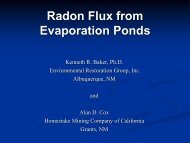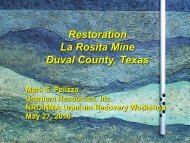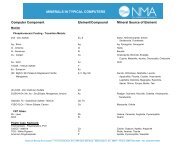Communication, Tracking & Breathing Technology - National Mining ...
Communication, Tracking & Breathing Technology - National Mining ...
Communication, Tracking & Breathing Technology - National Mining ...
Create successful ePaper yourself
Turn your PDF publications into a flip-book with our unique Google optimized e-Paper software.
<strong>Communication</strong>, <strong>Tracking</strong> &<br />
<strong>Breathing</strong> <strong>Technology</strong><br />
…What are the options?<br />
Jeffrey H. Welsh<br />
Pittsburgh Research Laboratory
Outline<br />
<strong>Communication</strong>, <strong>Tracking</strong>…<br />
• Current Mine <strong>Communication</strong> Devices<br />
• MINER Act requirements<br />
• What’s available now<br />
• <strong>Technology</strong> Gaps<br />
• Activities to help provide the technology<br />
Pittsburgh Research Laboratory
<strong>Breathing</strong> <strong>Technology</strong>…<br />
Outline (cont)<br />
• Current SCSRs<br />
• MINER Act requirements<br />
• SCSR Training<br />
• Activities to help provide the technology<br />
Pittsburgh Research Laboratory
Current Mine <strong>Communication</strong><br />
Devices<br />
• Telephones<br />
• Pager Phones (Loudspeaking Telephones)<br />
• Handheld 2-way 2<br />
radios<br />
• Leaky Feeder Systems<br />
Pittsburgh Research Laboratory
These systems rely on in-<br />
mine cables & components…<br />
…that can be destroyed in a disaster<br />
Pittsburgh Research Laboratory
The MINER Act<br />
…<strong>Communication</strong>s and <strong>Tracking</strong><br />
! General Requirements<br />
Pittsburgh Research Laboratory
Post-Accident <strong>Communication</strong>s<br />
MINER Act<br />
At a minimum, provide for a<br />
redundant means of<br />
communication with the<br />
surface for persons<br />
underground, such as<br />
secondary telephone or<br />
equivalent two-way<br />
communication.<br />
Program Policy Letter<br />
When hardwired systems are<br />
used to meet the MINER Act<br />
requirement for redundant<br />
communication between<br />
surface and underground<br />
personnel, wires should be<br />
routed through separate<br />
entries or boreholes<br />
continuous to the surface.<br />
Pittsburgh Research Laboratory
Post-Accident <strong>Tracking</strong><br />
MINER Act<br />
Provide for above ground<br />
personnel to determine the<br />
current, or immediately preaccident,<br />
location of all<br />
underground personnel.<br />
Any system so utilized shall<br />
be functional, reliable, and<br />
calculated to remain<br />
serviceable in a post-accident<br />
setting.<br />
Program Policy Letter<br />
Until post-accident tracking<br />
technology becomes<br />
commercially available and<br />
MSHA approved, MSHA will<br />
accept a dispatcher system,<br />
or equivalent system, that has<br />
as a function the tracking of<br />
persons underground.<br />
A dispatcher system should<br />
track location of personnel in<br />
writing, on a map, or<br />
electronically, for the duration<br />
of the shift.<br />
Pittsburgh Research Laboratory
The MINER Act<br />
…<strong>Communication</strong>s and <strong>Tracking</strong><br />
! Specific Requirements for “within 3 years”<br />
Pittsburgh Research Laboratory
Post-Accident <strong>Communication</strong>s<br />
MINER Act<br />
Within 3 years, Provide for post<br />
accident communication<br />
between underground and<br />
surface personnel via a wireless<br />
two-way medium.<br />
Program Policy Letter<br />
MSHA interprets the term<br />
“wireless”, as used in the MINER<br />
Act, to mean that no wired<br />
component of the system exists<br />
underground where it may be<br />
damaged by fire or explosion.<br />
Post-accident communication<br />
technology would be considered<br />
acceptable if, based on its<br />
location in the mine and the<br />
history of mine explosions and<br />
fires in the mine, it is likely to<br />
withstand the event intact.<br />
Pittsburgh Research Laboratory
Post-Accident <strong>Tracking</strong><br />
MINER Act<br />
Within 3 years, Provide for<br />
an electronic tracking system<br />
permitting surface personnel<br />
to determine the location of<br />
any persons trapped<br />
underground.<br />
Pittsburgh Research Laboratory
What’s Available Now?<br />
Pittsburgh Research Laboratory
R<br />
BC<br />
BC<br />
R<br />
R<br />
R<br />
R<br />
R<br />
R<br />
<strong>Communication</strong> Systems Tests<br />
Mine Emergency <strong>Communication</strong><br />
Systems Partnership<br />
CONNER'S<br />
RUN PORTAL<br />
#1 BELT<br />
DRIVE<br />
CROSSCUT 2-1<br />
DIP AREA<br />
Designated Return<br />
#3 BELT<br />
DRIVE<br />
BELT<br />
SLOPE<br />
Designated Return<br />
1,000 ft<br />
#2 BELT<br />
DRIVE<br />
600ft OVERBURDEN<br />
TEST AREA<br />
500ft OVERBURDEN<br />
TEST AREA<br />
TRACK AND<br />
BELT ENTRY<br />
TEST AREA<br />
S-TURN<br />
TEST AREA<br />
PARALLEL ENTRY<br />
TEST AREA<br />
270ft OVERBURDEN<br />
TEST AREA<br />
ELEVATOR<br />
FISH CREEK<br />
PORTAL<br />
SUPPLY<br />
SLOPE<br />
Pittsburgh Research Laboratory
Criteria for Selecting Systems<br />
for Testing<br />
• Systems that do not rely on a wire<br />
back-bone bone to operate<br />
• Various types of technology are<br />
represented<br />
• Evidence of sufficient development<br />
Pittsburgh Research Laboratory
Systems Tested<br />
• Rajant<br />
• Time Domain/Concurrent Technologies<br />
• Geosteering<br />
• Innovative Wireless Technologies<br />
• Kutta Consulting<br />
• Transtek<br />
• Vital Alert (Withdrew)<br />
Pittsburgh Research Laboratory
• All prototypes<br />
Pre-Test Facts<br />
• First coal mine test for most systems –<br />
the many challenges of a mine<br />
environment was not expected by the<br />
vendors<br />
Pittsburgh Research Laboratory
Test Process- evaluation criteria<br />
• For in-mine communications<br />
– Line-of<br />
of-site<br />
– Non-line<br />
line-of-site<br />
– Interference<br />
• For through-the<br />
the-earth earth communications<br />
– Depth of penetration<br />
• For in-mine tracking<br />
– Ability to track<br />
Pittsburgh Research Laboratory
Preliminary Test Results<br />
• Most systems limited to 1000-2000 ft.<br />
Line-of<br />
of-site communications<br />
• Exception – MF system provided >5387<br />
ft. non-line<br />
line-of-site voice communication<br />
(>11,600 ft. in a 2 nd test)<br />
• One vendor achieved 270 ft. TTE voice<br />
communication<br />
Pittsburgh Research Laboratory
Preliminary Test Results<br />
Rajant<br />
Time Domain/Concurrent<br />
Technologies<br />
Geosteering<br />
Innovative Wireless<br />
Kutta Consulting<br />
Transtek<br />
In-mine, Line-of<br />
of-<br />
sight range (ft)<br />
1500<br />
2000<br />
1000<br />
1800<br />
>11600 (was<br />
non-line<br />
line-of-site)<br />
N/A<br />
Through-the<br />
the-<br />
earth range (ft)<br />
N/A<br />
N/A<br />
270 (Beacon)<br />
N/A<br />
631 (Text)<br />
270 (Voice)<br />
Pittsburgh Research Laboratory
MINE<br />
SITE<br />
PED AND TRACKER<br />
INVESTIGATION<br />
(by MSHA)<br />
• Investigate PED installations at:<br />
– Peabody Air Quality and Twentymile Mines<br />
– Consol Blacksville and Robinson Run Mines<br />
– BHP San Juan Mine (only surface-installed antenna in<br />
the US)<br />
• Traveled to Australia to investigate TRACKER<br />
installation<br />
Pittsburgh Research Laboratory
• Pros:<br />
PROS<br />
AND CONS<br />
OF PED<br />
– Can send evacuation instructions to miners in early stages of fire<br />
– Can be retrofit for Koehler, NLT and MSA cap lamps<br />
– System can be deployed in emergency by arranging surface<br />
loop antenna<br />
• Cons:<br />
– Underground antenna could be compromised in fire or explosion<br />
– Reports of some areas where signals can’t be received (shadow<br />
zones)<br />
– Can interfere with existing mine systems<br />
– <strong>Communication</strong>s limited to one-way<br />
– No confirmation that message has been received<br />
Pittsburgh Research Laboratory
PROS<br />
AND CONS<br />
OF TRACKER<br />
• Pro: Can provide last known location of<br />
miner before loss of power<br />
• Cons:<br />
– Cannot provide precise location of personnel<br />
– System will become non-operational operational upon<br />
loss of power<br />
Pittsburgh Research Laboratory
What are the <strong>Technology</strong> Gaps?<br />
• Limited in-mine range requires significant<br />
in-mine components & infrastructure<br />
• Through-the<br />
the-earth earth communication has<br />
limitations<br />
• Ability to be Intrinsically Safe<br />
• Systems are prototypes<br />
Pittsburgh Research Laboratory
Activities to help provide the<br />
necessary technology<br />
• Mine Emergency <strong>Communication</strong>s<br />
Systems Partnership<br />
• Emergency Supplemental Appropriations<br />
Bill<br />
• Other Activities<br />
Pittsburgh Research Laboratory
Mine Emergency <strong>Communication</strong><br />
Systems Partnership<br />
Conduct in-mine tests on systems<br />
Pittsburgh Research Laboratory
Emergency Supplemental<br />
Appropriations Bill<br />
• $10M to push promising technology to the<br />
mines<br />
– Funding to be administered by NIOSH<br />
through outside contracts<br />
– Divided between communications & tracking,<br />
SCSRs, refuge chambers<br />
Pittsburgh Research Laboratory
Funding Targets Areas…<br />
• Harden existing communications systems<br />
• Hybrid communications technology<br />
• New communications systems<br />
• New tracking systems<br />
Pittsburgh Research Laboratory
Harden existing communications<br />
systems<br />
• Protect cables and components<br />
– Armor or conduit<br />
– Burying<br />
• Enhance system<br />
– Loop-Around<br />
Pittsburgh Research Laboratory
Hybrid Systems<br />
• During normal operations, function using<br />
existing communication systems<br />
• In an emergency, use the same wireless<br />
components to function in another mode<br />
that has greater chance of survival<br />
– Example: Leaky feeder for normal operations<br />
and medium frequency in an emergency,<br />
using the same portable radio<br />
Pittsburgh Research Laboratory
Other <strong>Communication</strong> System<br />
Issues<br />
• Interoperability<br />
• Interference<br />
• System safety<br />
Pittsburgh Research Laboratory
Actions…<br />
• Award contracts for development &<br />
demonstration projects<br />
• Continue to test promising technology<br />
• Award contracts for research issues<br />
• Share information through Partnership &<br />
NIOSH Web site<br />
Pittsburgh Research Laboratory
<strong>Breathing</strong> <strong>Technology</strong><br />
Pittsburgh Research Laboratory
MSHA/NIOSH Approved SCSRs<br />
CSE SR-100<br />
Draeger OXY-K Plus<br />
MSA Life Saver 60<br />
Ocenco EBA 6.5<br />
Ocenco M-20<br />
Pittsburgh Research Laboratory
The MINER Act<br />
…<strong>Breathing</strong> <strong>Technology</strong><br />
Pittsburgh Research Laboratory
Post-Accident Breathable Air<br />
MINER Act<br />
Emergency supplies of breathable<br />
air for individuals trapped<br />
underground sufficient to maintain<br />
such individuals for a sustained<br />
period of time<br />
In addition to the 2 hours of<br />
breathable air per miner required<br />
by the emergency temporary<br />
standard, caches of self-rescuers<br />
providing in the aggregate not less<br />
than 2 hours per miner to be kept in<br />
escapeways from the deepest work<br />
areas to the surface at a distance of<br />
no further than an average miner<br />
could walk in 30 minutes<br />
Program Policy Letter<br />
MSHA interprets “caches of<br />
self-rescuers providing in the<br />
aggregate not less than 2<br />
hours per miner to be kept in<br />
escapeways” to mean that onehour<br />
of oxygen per miner<br />
should be provided at each<br />
SCSR storage location in each<br />
escapeway.<br />
Pittsburgh Research Laboratory
Distances for SCSR Storage<br />
Locations<br />
Average Seam Height<br />
(in.)<br />
Crawl – less than 40<br />
Duck Walk – 40 to 50<br />
Walk Head Bent – 51 to<br />
65<br />
Walk Erect – more than<br />
65<br />
Distance in Feet (30<br />
min.)<br />
2173<br />
3328<br />
4415<br />
5738<br />
Pittsburgh Research Laboratory
Post-Accident Breathable Air<br />
MINER Act<br />
Provide for:<br />
A maintenance schedule for checking<br />
the reliability of self-rescuers, retiring<br />
older self-rescuers first, and<br />
introducing new self-rescuer<br />
technology, such as units with<br />
interchangeable air or oxygen<br />
cylinders not requiring doffing to<br />
replenish airflow and units with<br />
supplies of greater than 60 minutes, as<br />
they are approved by the<br />
Administration and become available<br />
on the market.<br />
Training for each miner in proper<br />
procedures for donning self-rescuers,<br />
switching from one unit to another,<br />
and ensuring a proper fit.<br />
Program Policy Letter<br />
Specify a schedule for opening,<br />
initiating the breathing cycle, and<br />
establishing operational<br />
reliability for a representative<br />
number of SCSR units on an<br />
annual basis.<br />
Provide for replacement of<br />
retired SCSRs with<br />
technologically advanced<br />
SCSRs as they become<br />
commercially available and are<br />
approved for use in mines.<br />
Pittsburgh Research Laboratory
SCSR Training …<br />
•Hands On Switchover Training<br />
•Care and Maintenance of SCSRs<br />
Pittsburgh Research Laboratory
Switchover Training<br />
• A process with steps that are universal<br />
regardless of model of SCSR<br />
• Incorporates elements of the “3+3” donning<br />
procedure<br />
• Packaged on a single DVD<br />
Pittsburgh Research Laboratory
Switchovers Assessed<br />
Photos: Ocenco, Inc.<br />
Photos: Ocenco, Inc.<br />
Pittsburgh Research Laboratory
Care and Maintenance of<br />
Self-Contained Self-Rescuers<br />
Training for miners about…<br />
• How to properly<br />
conduct daily and 90<br />
day inspection<br />
• How to care for an<br />
SCSR<br />
• Criteria for removing an<br />
SCSR from service<br />
Pittsburgh Research Laboratory
Components of the package …<br />
• Instructor’s guide<br />
• Videotape<br />
• CBT module<br />
• Hands-on component<br />
• Hardhat sticker<br />
• Screen saver<br />
Pittsburgh Research Laboratory
Emergency Supplemental<br />
Appropriations Bill - Funding<br />
Targets Areas…<br />
• Hybrid <strong>Technology</strong> Self Rescue Respirators<br />
• Dockable SCSRs<br />
• New Materials / Systems Designs<br />
Pittsburgh Research Laboratory
Hybrid Self Rescuers<br />
Combination SCSR and FSR Respirator – once<br />
life support capacity of SCSR part is expended,<br />
device switches into FSR mode, filtering out CO<br />
from ambient air<br />
• <strong>Technology</strong> required:<br />
– FSR Mode<br />
• Traditional <strong>Technology</strong> → Hopcalite to convert CO -> CO 2<br />
(high inhaled<br />
gas temp)<br />
• New <strong>Technology</strong> → use CO Oxidation Catalysts (reaction at lower temp)<br />
– When/How to switch from closed- to open-circuit operation<br />
• Sensing CO & O 2<br />
• Switching → Mode of Operation<br />
Pittsburgh Research Laboratory
Dockable SCSR<br />
Dockable Short & Long Duration SCSR – Belt<br />
wearable short duration unit whose duration can<br />
be repeatedly extended by coupling new life<br />
support canisters on to it<br />
– Additional Canisters Coupled to an SCSR<br />
• Eliminates Multiple Donning<br />
• Allows for Smaller, Lighter Carried SCSR<br />
– This type of unit is allowable under interpretations of<br />
current MSHA regulations (30 CFR Part 75.1714) which<br />
permits a 10/60 SCSR<br />
Pittsburgh Research Laboratory
Schematic Dockable SCSR<br />
Pittsburgh Research Laboratory
New Materials / Systems<br />
• Treatments<br />
– Catalytic Coatings<br />
– Pelletizing<br />
Designs<br />
• Pressure Vessels — Carbon Cylinders<br />
• User Interface Concepts — Hoods<br />
• Packaging Sealed Foil Pack<br />
– Hermetically Sealed Chemicals<br />
– Exchangeable Packs<br />
Pittsburgh Research Laboratory
Mine Worker Health & Safety<br />
The findings and conclusions in this presentation have not been<br />
formally disseminated by the <strong>National</strong> Institute for Occupational<br />
Safety and Health and should not be constituted to represent any<br />
agency determination or policy. Mention of any company name or<br />
product does not constitute endorsement by NIOSH.<br />
Pittsburgh Research Laboratory


